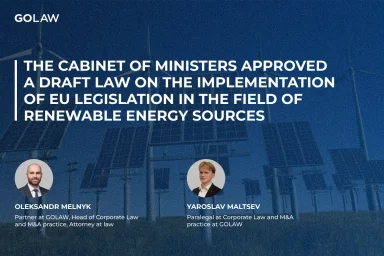Is there still any future for renewable energy in Ukraine?
Tags
Contents
- “Green” tariff reduction
- Changes to auction procedures on distribution of state support quotas
- Liability for imbalances
- What next?
- Legitimate expectations of the investors
- Balancing investor protection with the sovereign right of the state to regulate and amend its legislation
- Investor expectations must be subject to evaluation when making an investment
In the summer of 2020, Ukraine’s renewable energy market underwent another string of changes, this time mainly because of the “green” tariff reduction. After more than six months of negotiations, “green” energy investors and the government managed to reach some consensus on how to protect the market against the default of the State Enterprise Guaranteed Buyer (hereinafter – Guaranteed Buyer) which was initially reflected in the memorandum on the so-called “green” tariff restructuring and later found its own legislative settlement.
The need for such change was caused mainly by the Guaranteed Buyer’s increasing indebtedness to renewable energy producers. According to the Guaranteed Buyer’s official website, as of August 20, 2020, the state-owned enterprise had approximately 70 percent indebtedness to renewable energy producers outstanding from January 1, 2020.
The provisions of the memorandum were not acceptable to some market players. Since the Law “On Amendments to the Laws of Ukraine to Improve Support to Electricity Generation from Alternative Energy Sources” (hereinafter – the Law) that was adopted in pursuance of the memorandum included conditions even less favorable for investors, many investors immediately started considering options to seek compensation from the government for the losses as the result of legislative changes. The main changes introduced by the Law included the following.
“Green” tariff reduction
The “green” tariff rate was reduced for operating solar and wind power installations by introducing reduction coefficient. These changes mostly affected solar energy producers. The reduction would be 15 percent for solar power plants (hereinafter – SPPs) commissioned between 01/07/2015 and 31/12/2019 with capacity of 1 MW and more, or 7.5 percent for plants with capacity of less than 1 MW.
For SPPs with capacity of 1 to 75 MW, the “green” tariff reduction would be 2.5 percent for plants commissioned between 01/01/2020 and 31/10/2020, 30 percent for plants commissioned between 01/11/2020 and 31.03.2021, and 60 percent for plants commissioned after 01/04/2021.
For SPPs with capacity of more than 75 MW, the “green” tariff reduction would be 2.5 percent for plants commissioned between 01/01/2020 and 31/10/2020, and 60 percent for plants commissioned after 01/11/2020.
For wind power plants (hereinafter – WPPs), the “green” tariff reduction would be less substantial constituting 7.5 percent for plants with a wind turbine of capacity of 2,000 kW and more commissioned between 01/07/2015 and 31/12/2019, and 2.5 percent for plants commissioned after 01/01/2020.
Changes to auction procedures on distribution of state support quotas
Whereas previously the law clearly stated that auctions on distribution of state support quotas should be held twice per year, not later than April 1 and October 1 of the current year, from now on, they will be scheduled by the Cabinet of Ministers annually not later than December 1. The Cabinet of Ministers will also set the annual assistance quotas for renewable energy producers which at this time are quite difficult to predict but will clearly not be enough for all.
Liability for imbalances
Another essential change is introduction of liability for imbalances between actual and projected electricity generation for renewable energy producers. Starting from January 1, 2021, the liability for imbalances will be 50 percent, and starting 2022 the liability will be 100 percent. Power plants with capacity less than 1 MW will remain liable for imbalances at the existing rates, meaning that starting from January 1, 2021, the liability rate would increase 10 percent annually and reach 100 percent by 2030.
Another critical issue that remains unresolved is payment of the Guaranteed Buyer’s indebtedness to renewable energy producers that continues to increase.
What next?
Both investors and the government are aware of the high likelihood of court and arbitration actions against Ukraine.
There is already a number of lawsuits in local courts initiated by renewable energy producers against the Guaranteed Buyer on debt recovery.
For instance, in the case 910/9882/19, a solar power plant filed a lawsuit against the Guaranteed Buyer with the Kyiv Commercial Court seeking to recover a debt, impose late payment charges, and charge a 3 percent annual interest for delayed payments under the PPA.
Once the action was brought, the Guaranteed Buyer paid off the debt to the energy producer in full but claimed that there were no legitimate grounds for charging a 3 percent annual interest and late payment penalty as it was not at the fault for the late payment.
The court dismissed the argument and stated that the Guaranteed Buyer was under an obligation to pay “green” tariff rate of the projected cost of electricity to the claimant in due time, including penalty for improper performance of contractual obligations. The lack of funds and improper performance of contractual obligations by third parties may not exempt the defendant from performing contractual obligations to the other party pursuant to the existing legislation.
The court of appeals further upheld the decision. Ultimately, the Guaranteed Buyer was charged a 3 percent annual interest and late payment penalty.
Certain investor groups have also been consulting domestic and foreign advisors about whether their cases are strong enough for international investment arbitrations.
The international experience of violations of government guarantees to renewable energy investors suggests that the latter have good chances of proving to court the breaches of their legitimate expectations of regulatory stability at the time when the investments were made.
Ukraine, like member states of the European Union, is party to the European Energy Charter (hereinafter – the Charter). The Charter provides for promotion of fair and equal treatment of investors, stable, equitable, favorable and transparent conditions for investors, and the concept of reasonable expectations which, combined, are crucial in resolving such arbitration disputes.
Notably, Ukraine is by no means the first country in Europe that adopted a similar approach of making changes to its renewable energy policy. Even though the direction of changes in some countries such as Spain and Italy was different to what we are witnessing in Ukraine, the general concept was very similar as Ukraine followed virtually the same path by reducing the “green” tariff rate and encouraging new market players to opt for a different type of government assistance in the form of “green” auctions. In 2007, Spain introduced a number of regulatory measures to encourage investments into renewable energy. However, the renewable energy investment boom of 2007-2008, a tariff deficit and the impact of the financial crisis forced Spain to adopt a series of measures abolishing all incentives for renewable energy producers, starting in 2010. Consequently, close to forty arbitration claims were brought against Spain. The majority of claims involved key issues such as violation of the fair and equal treatment standards and breach of legitimate expectations of investors.
In this instance, the arbitration courts took different positions and singled out the following issues that ended up being crucial in proving the positions of the investors and the government.
Legitimate expectations of the investors
In the case of Charanne v. Spain, the investors claimed that the regulatory framework established by Spain before the crisis of 2008 encouraged them to invest in Spain and gave rise to legitimate expectations that the conditions for investors would not change. The arbitration court held, however, that the measures taken by Spain could not have given rise to legitimate expectations as the relevant documents were not sufficiently specific. The decision suggests that nothing except a stabilization clause or a specific commitment to the investors that the regulatory framework will remain unchanged can give rise to legitimate expectations.
In the case of Novenergia v. Spain, the arbitration court argued the opposite and resolved that legitimate expectations do not necessarily have to rely on any specific measures such as contractual stabilization clauses. It is the actions of the state that inherently create such expectations. Therefore, the arbitration court ruled that the investor had every right to legitimately expect the policy that was in force as of 2007 to remain in effect based on the statements made by Spain’s Congress of Deputies members as well as Spain’s marketing documents which the arbitration court called a “bait”.
Balancing investor protection with the sovereign right of the state to regulate and amend its legislation
The arbitration courts pointed out that whenever the state amends the provisions governing the “green” energy sector, it has to properly balance the interests of investors who invest significant resources and the interests of the state that has the right to regulate and amend its legislation depending on the circumstances, provided that this right is exercised in a proportionate, reasonable, and non-discreet manner and serves the public interest (The PV Investors v. Spain, PCA Case No. 2012-14).
Investor expectations must be subject to evaluation when making an investment
The arbitration courts stress that the investor’s subjective beliefs that the investor had when making an investment are not sufficient and that the “legitimacy” of the expectations must be evaluated against the statements made by the government to encourage investment (Charanne B.V. and Construction Investments S.a.r.l. v. Spain). Because of this, producers that made their investments earlier would have a better chance of proving their legitimate expectations of stability of the legal framework compared to those that invested later, when certain changes became evidently imminent.
Currently, we see that certain groups of renewable energy investors have potential to sue the government for debt recovery and damages. However, we have to understand that arbitration may not suit everyone. First of all, the arbitration process entails significant costs, takes a long time and requires patience. Therefore the ratio of costs and time spent to the possible outcome of the arbitration court’s ruling makes it hardly feasible for some investors. Secondly, those investors and developers who so far have made only some investments (e.g. leased land or developed the projects) but have not yet started construction of the power plants have a significantly lower chance of recovery of lost profits through arbitration courts.
On the other hand, the issue of taking action to recover the debts from the Guaranteed Buyer is a “headache” for directors of renewable energy producers considering that pursuant to the Code on Bankruptcy Procedures, in the event of lack of appropriate action by the director, that led to the power plant’s bankruptcy, the director shall bear subsidiary liability to the creditors.
Associations and individual investors are currently in active negotiations with the government about the ways and deadlines for repayment of the Guaranteed Buyer’s existing debt. However, given that the problem is unlikely to be resolved shortly, the investors ought to be already designing their strategies to protect their interests in court.
Related insights

18 December 2025 Publication
Supreme Court: Permanent Residence Abroad Does Not Cancel Military Obligation

16 December 2025 Publication
The Cabinet of Ministers approved a draft law on the implementation of EU legisl...

12 December 2025 Publication
Seizure of assets in foreign banks: legal ways to protect your interests
Sign up to be aware
New achievements are inspired by information. GO further, don’t miss out GOLAW news and legal alerts
Our expertise
-
- Energy and Natural Resources
- Antitrust and Competition
- Banking and Finance
- Compliance, Corporate Governance and Risk Management
- Corporate and M&A
- Criminal and White Collar Defence
- Defense in Anti-corruption procedures and regulations
- Labor and Employment
- Natural Resources and Environment
- Government Relations (GR)
- Insolvency and Corporate Recovery
- Intellectual property
- International trade
- Legal support of business and private Сlients in Germany
- Litigation and dispute resolution
- Private clients
- Real Estate and Construction
- Restructuring, Claims and Recoveries
- Martial Law
- Tax and Customs
-
- Agribusiness
- Aviation
- Chemical industry
- Engineering, Construction and Building Materials
- Environment and Natural Resources
- Financial institutions
- IT and AI
- Industry and manufacturing
- Healthcare industries, Life sciences and Pharmaceuticals
- Media, Entertainment, Sports and Gambling
- Retail, FMCG and E-Commerce
- Transport and Logistics
We use cookies to improve performance of our website and your user experience.
Cookies policy
Cookies settings




